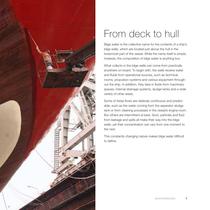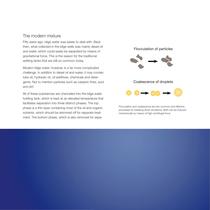
Catalog excerpts

A time for revolution The PureBilge system for bilge water treatment Alfa Laval can be found on board most ships and provides support through a global organization. Our products include systems for fuel conditioning, separation, heating, cooling, tank cleaning, filtration, desalination, waste treatment and ballast water treatment. Greater depth Lift the ap for a CD with multimedia content and additional PureBilge information. As a leading supplier, we strive for the most efficient, reliable and environmental solutions. Our drive is the partnership with our many customers – together we set the standard. For more information, please visit us at www.alfalaval.com/marine PureBilge and XLrator are trademarks owned by Alfa Laval Corporate AB. Alfa Laval is a trademark registered and owned by Alfa Laval Corporate AB. Alfa Laval reserves the right to change specifications without prior notification. EMD00208EN 0912
Open the catalog to page 1
The attached CD contains the following items: Animated presentation This animation serves as a concise introduction to the PureBilge system. Technical data leaet This leaet provides a brief technical overview of the PureBilge system and its operation A time for revolution The PureBilge system for bilge water treatment Technical booklet This booklet offers in-depth information about the issues involved in bilge water treatment and the technical characteristics of the PureBilge system.
Open the catalog to page 2
A time for revolution The PureBilge system for bilge water treatment
Open the catalog to page 3
Alfa Laval on board Alfa Laval can be found on most ships and in most onboard processes. In the course of a century at sea, we have gained a thorough understanding of the complex and ever-changing marine environment. That understanding is reflected in our PureBilge system for bilge water treatment. By means of c entrifugal separation, PureBilge offers continuous environmental protection that adapts to the shifting conditions on board. Even on the roughest of seas. Similar technology has protected ships’ engines for decades, which means the operating principle is well established....
Open the catalog to page 5
Ships are not still Traditional bilge water treatment systems rely on gravitational separation and other static methods to achieve 15 ppm oil in water. But when faced with today’s bilge water mixtures – which contain far more than just oil and water – these static technologies seldom perform at sea. Because in real life, the ocean is anything but static. In a pitching and rolling environment, complex and emulsified bilge water compositions can seldom be separated through gravity alone. This means that bilge water must be stored in large tanks until conditions are right for treatment, and...
Open the catalog to page 6
PureBilge treats bilge water through centrifugal separation – the same technology used to protect ships’ engines. By multiplying the effect of gravity, it avoids the use of chemicals and filters. In fact, PureBilge generally reduces oil in water to less than 5 ppm – without the use of filters or chemicals. PureBilge from Alfa Laval Put simply, Alfa Laval’s PureBilge is the most efficient and reliable separator available for bilge water treatment. Operating at flow rates of up to 5000 l/h, it provides fully automatic single-stage operation and easy compliance with the 15 ppm oil-in-water...
Open the catalog to page 7
From deck to hull Bi.go -.valor is (lie collective name for Ihe contents of a ship's bilge wells, which a'e locato:; urr. above the hull in the lowermost part of the vessel. While the name itself is simple, however, the com posit ¡01 ■ <y bilge water is anything but. What collects in the bilge wells can come from practically anywhere on board. To begin wth. the wells receive water one t aids tro;- opo'atioral source:; saon as technical rooms, propulsion systems arci ■■-■■arioi.s equipment through- out the ship. In ade tier, they take a "luios from machinery spaces, internal drainage...
Open the catalog to page 9
Solids sdiloS Water The modern mixture deeF Fifty years ago, bilge water was easier to deal with. Back then, what collected in the bilge wells was mainly diesel oil stelpo d o ecn of and water, which could easily be separatedrbyfmeansecselaoC gravitational force. This is the reason for the traditional settling tanks that are still so common today. Modern bilge water, however, is a far more complicated challenge. In addition to diesel oil and water, it may contain lube oil, hydraulic oil, oil additives, chemicals and deterFlocculation of particles gents. Not to mention particles such as...
Open the catalog to page 10
rate treatment, consists of solids and heavy sludge. In between is the phase to be handled by the bilge water treatment system, which contains water polluted by oil, chemicals and particles. particles and surfactants. Surfactants, which lower the surface tension of liquids and facilitate spreading, have become increasingly common in the detergents and chemicals used for cleaning and maintenance. While gravity is enough for this primary separation, it can seldom provide the secondary treatment needed before bilge water can be discharged. To destabilize emulsions, methods that induce...
Open the catalog to page 11
Taking chances All ships must have systems for bilge water treatment. IMO resolution MEPC 107 (49) allows only separated bilge water with an oil-in-water content of 15 ppm or less to be discharged into international waters. In some parts of the world, additional requirements or stricter limits have been set by national or regional autho rities. In US waters and in the Baltic and North Seas, for example, even treated bilge water can only be discharged at a distance of at least 12 nautical miles from shore. An oil-in-water limit of 5 ppm already exists in the Great Lakes region, and as...
Open the catalog to page 13
Questionable standards Strangely enough, the widespread inefficiency of bilge water treatment systems is partly due to the type approval process that regulates them. Prior to 2005, the type approval process was governed by IMO resolution MEPC 60 (33), which required only that treatment systems be tested with a mixture of oil and water. Today’s MEPC 107 (49) is substantially stricter, since it also requires testing with a stable emulsion that contains fine Modern satellite methods of tracking bilge water discharge have led to severe fines and prison sentences. Yet the tests associated with...
Open the catalog to page 14All Alfa Laval Mid Europe catalogs and brochures
-
i-40D
4 Pages
-
PureBilge
20 Pages
-
Lube oil filter – 350 series
3 Pages
-
Eliminator – CCU
4 Pages
-
Vibration dampers
2 Pages
-
F-152
4 Pages
-
Alfa Laval 290 Filter
4 Pages
-
AlfaBlue Junior DG
16 Pages
-
EPC 60 Retrofit
2 Pages
-
Alfa Laval three-screw pump
6 Pages
-
High Efficiency Evaporator
4 Pages
-
Always a step ahead
12 Pages
-
A new tide of savings
12 Pages
-
Desalt DPU-2-36-C Series
4 Pages
-
PureNOx Prime
4 Pages
-
LPG carriers
2 Pages
-
LNG carriers
2 Pages
-
Alfa Laval AC16 / ACH16
2 Pages
-
Alfa Laval AC112 / ACH112
2 Pages
-
Alfa Laval AC500DQ /ACH500DQ
2 Pages
-
PureNOx
2 Pages
-
Marine Essentials
100 Pages
-
Fincoil Solar Max
10 Pages
-
Aalborg TFO
10 Pages
-
Tank equipment for hygienic use
12 Pages
-
Aalborg OC
2 Pages
-
Aalborg D
2 Pages
-
BAlfa Laval PureBallast 3.1
6 Pages
-
ALF - Alfa Laval Filter
4 Pages
-
Aalborg KBE
2 Pages
-
Central cooling - T35
2 Pages
-
Ball valve UltraPure
4 Pages
-
Crushers and depitters
4 Pages
-
Compabloc
4 Pages
-
AlfaBlue BXM/BXD
2 Pages
-
Alfa-v-single-row-vxm
2 Pages
-
Alfa-V ACV
2 Pages
-
PureSOx
16 Pages
-
PureDry
4 Pages
-
PureBallast 3.0
6 Pages
-
Heating Insulation
2 Pages
-
Cooling Insulation Type P
2 Pages
-
CB100 / CBH100
2 Pages
-
Alfa Laval AOT 3F
2 Pages
-
AlfaRex - TM20
2 Pages
-
AlfaDisc
2 Pages
-
AlfaCond range
2 Pages
-
Eliminator CCU
4 Pages
-
Advanced Cooling System
4 Pages
-
MIB 303
4 Pages
-
EMD00062EN Emmie
2 Pages
-
Here30_ENG.pdf
36 Pages
-
MOPX Separation Systems
4 Pages
-
Plate heat exchanger
2 Pages
-
Lubricating oil filter
4 Pages
Archived catalogs
-
Desalt DPU-36-C Series
4 Pages







































































































